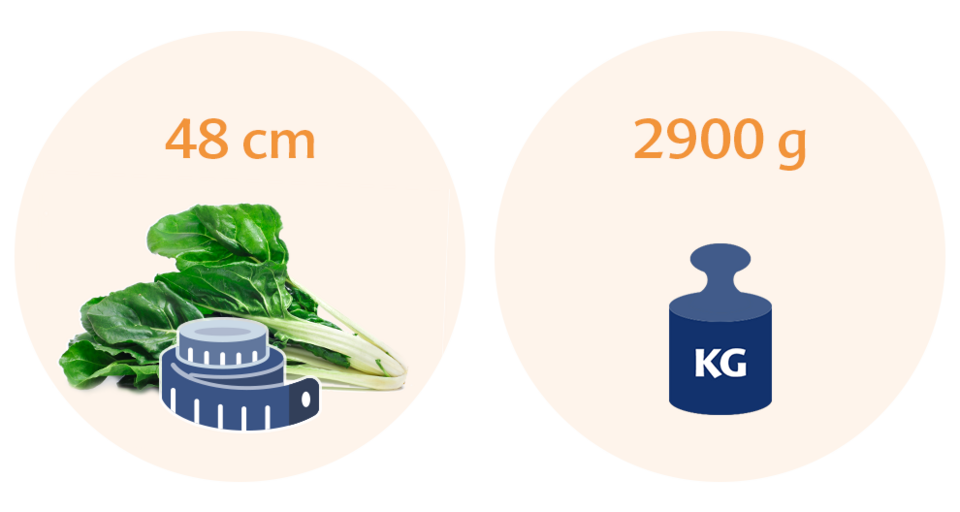Your baby has gained another centimetre in length since last week, making them now 48 cm long and as big as a chard. They weigh 2927 grams, nearly 3 kilograms, so they’ll soon be at their birth weight.
Pregnancy weeks:
Week 37 of pregnancy: Your child can now be born as a full-term baby

Size of your baby in week 37
Your baby’s development
What it’s like for the mum-to-be in week 37
Top tips
Questions you may want to ask your doctor or midwife
In week 37, you’re in the tenth month of your pregnancy. People often think pregnancy lasts 9 months, but it’s actually a little longer until the baby is born, so it’s best to think of it as lasting about 9 ½ months. You’ll be working hard to get ready for life as a mum, and your baby is also doing everything they can to prepare for the day when they’re born into the big wide world, lie in your arms and smell their parents for the first time.
Size of your baby in week 37

Your baby’s development
From week 37, your baby is ready for birth and life outside your womb. They’ll use the remaining time until the big day to put on more fat reserves, gaining around 20-30 grams a day in body mass. Around 15 per cent of their body weight is now fat, which allows them to maintain and regulate their body temperature after they’re born so that they don’t get too cold and can develop healthily. The fat cells are designed so that they can convert the fat into heat in each individual cell, meaning that your newborn baby can keep their body temperature more or less constant.
Now, shortly before birth, your baby loses most of their lanugo hair and the waxy vernix caseosa coating their skin. A little of both will remain and be visible on their skin when they’re born, and this can be used by an experienced midwife to determine their exact age. Severely overdue babies usually have (almost) no vernix caseosa left, and the smoothness of their skin indicates their age and development.
Your baby’s skull and brain continue to grow until the birth, while their other organs are already fully formed and doing their jobs. The lanugo hair and skin cells they have shed are absorbed into the amniotic fluid, which they continue to drink. These will form part of the meconium, a black, sticky substance produced in their intestine and excreted from their body as their first stool after they’re born.
In week 37, the false labour has usually resulted in their little head moving down towards your lesser pelvis, which is the ideal position for birth. It’s an uncomfortable position for them as they can’t move much, so they’re impatient to come out of your womb and move around more freely. Most babies spend this time sleeping, gathering strength for the day they leave your womb.
What it’s like for the mum-to-be in week 37
You’re bound to be feeling restless and agitated about what you’re about to experience. Especially if this is your first baby, you’ll be unsure what your body’s symptoms mean and won’t know whether or not they indicate that birth is imminent.
Midwife’s advice
‘They say this is the time you begin to get “fed up” with pregnancy and just want to get it over with. That’s normal and not a bad thing – it won’t be long until you have your baby.’ Dorothee Kutz, midwife
You’re approaching the end of your pregnancy calendar and don’t have much time to make the final preparations for the arrival of your baby. By now, you should know for certain where you want to have your baby and who you want to have with you while you give birth. Your bag should be packed, and both you and your partner should know where it is for when you need it in a hurry. If you haven’t done so yet, you absolutely must make a plan with your partner for when you want to be taken to the midwifery unit/hospital or when you want the midwife you’ve hired to be with you.
Common signs and symptoms
Your internal organs feel increasing pressure
If false labour (which moves your baby down into your lesser pelvis so that they’re in the position for birth) hasn’t happened yet, it will this week. This will increase the load on your lesser pelvis and pelvic floor, which you’ll feel as a kind of downward pressure, though it does mean your lungs won’t be as squeezed and you can breathe more freely. Exercises where you move in a gentle, circular motion will help you avoid pelvic floor muscle cramps, alleviate the pressure and make you more relaxed, as well as help your baby get into position for birth.
Noticing the first signs that birth is imminent
The process of giving birth could now begin at any time. Frequent early signs you may experience are wind with diarrhoea, vomiting, headaches, serious backache and abdominal pain, but the major sign that real labour is on its way is when you notice discharge containing blood. This indicates that the mucus plug in front of your cervix is finally loosening. When real labour begins, the amniotic sac will burst (your “waters break”) in most cases, which you’ll notice as a trickle or gush of amniotic fluid coming out of your vagina. It will bring on labour and therefore birth, so you shouldn’t leave it any longer before setting off for the hospital – even if you don’t experience labour immediately after your amniotic sac bursts, you should go there straight away.
Midwife’s advice
‘If you’re unsure if it’s practice labour or the real thing, you can place a hot water bottle or cherry stone pillow on your back. If the contractions ease, it was practice labour.
Another clue is if you’re able to speak during the contractions: if not, it’s the real thing and you should go straight to the hospital.
If you start feeling unwell at home, always go straight to hospital. Also remember to factor in how far away you live from the hospital when deciding when to go in.’ Dorothee Kutz, midwife
Top tips
- Get as much rest as you can and try to enjoy the remainder of your pregnancy with your loved ones.
- Come up with a plan for the moment birth begins: How will you get to the hospital/midwifery unit? Who will go with you? Who will you tell and when? Do you know where your bag is? This will help you by reducing your stress levels.
- You can wear highly absorbent sanitary towels to avoid getting your underwear wet if your waters suddenly break.
- Start thinking about the time after the birth, when you’ll be recovering your strength in order to cope with the everyday reality of having a baby.
Questions you may want to ask your doctor or midwife
Reacting to the signs that birth is imminent
You’re extremely well equipped with all this theoretical knowledge about the bodily symptoms that indicate you’re about to give birth. Nonetheless, it’s common to feel unsure. So discuss all the eventualities with your midwife, who can tell you for which symptoms you’re entitled to her help – she should be available on her mobile at all times around your due date, and you can ask if this includes during the night as well. Get her to explain what will happen and when after the birth, and how she will support you and your baby at home. This will give you peace of mind and enable you to face the challenge of giving birth with confidence.
Information about the author:
Juliane Jacke-Gerlitz is a registered nurse. She has been working in the field of mother and breastfeeding counselling for more than ten years. Currently she is working as a medical writer and psychological consultant. Juliane Jacke-Gerlitz has been married for 22 years, is a mother of eight children and lives with her family in Halle.




